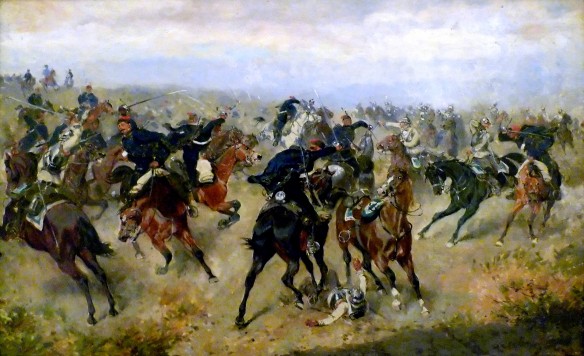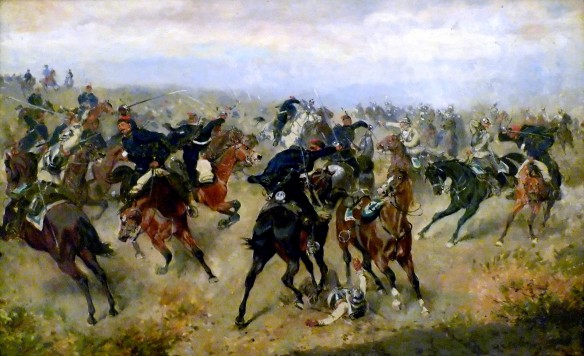While there is general consensus about the momentous consequences of Königgrätz, there is no agreement about why the battle went the way it did. Historians continue to debate whether it was Prussian competence or Austrian incompetence that accounted for the outcome. The safe answer, which has the added advantage of being true, is that it was a bit of both.
There is no question that Benedek played his hand badly. He failed to decisively attack the Prussians when they were at their weakest, while wending their way through the passes of the Giant Mountains. He then failed to take advantage of his initial success at Königgrätz on the morning of July 3. Until the early afternoon, the Austrians had a large numerical advantage over their Prussian opponents. If Benedek had gambled on an all-out offensive, he might have been able to crush the Elbe Army and the First Army before the Second Army arrived. Failing that, Benedek should have retreated while the going was still good. Instead he stayed in place, leaving his right flank dangerously exposed, and suffered the consequences. Moltke later commented that “[n]o one, of course, dreamed” that the enemy would open themselves up in this fashion.
The needle gun further contributed to the Austrian defeat. Time after time, their superior breechloaders allowed small Prussian units to maul more numerous adversaries. Fransecky’s heroic 7th Division never could have held its pivotal position in the Swiepwald were it not equipped with rapid-fire rifles. As Friedrich Engels wrote afterward: “It may be doubted whether without [the needle gun] the junction of the two Prussian armies could have been effected; and it is quite certain that this immense and rapid success could not have been obtained without such superior fire, for the Austrian army is habitually less subject to panic than most European armies.”
Railways also helped determine the outcome. In just twenty-one days, the Prussians transported 197,000 men and 55,000 horses. Their rapid concentration and advance caught the Austrians off guard. The whole conflict lasted just seven weeks. The war against France four years later took slightly longer, because the French people refused to admit they were beaten, but the major combat was also relatively brief, in large part because the Prussians once again were able to transport and concentrate troops more rapidly than their foes.
Of course, railroads and guns do not operate themselves. The human factor must never be lost sight of. Observers generally agreed on the superior motivation and training of Prussian troops. An English journalist found that, in contrast to the peasant conscripts who made up the Austrian ranks in 1866, the Prussian “rank and file are men of education, who know what they are fighting about, not mere machines drilled to mechanical perfection.” They were thus “more in earnest, more thoughtful, more willing to risk their lives for a principle, whether false or true, more imbued with a sense of duty.”
Prussian commanders were also more thoughtful and more earnest than their Austrian counterparts. Above all, the genius of Helmuth von Moltke towered over the battlefield. As a reward for his service, the chief of staff was awarded a large cash grant by his grateful king, which allowed him to purchase a thousand-acre estate in Silesia. A few years later, his victory over France would earn him promotion to field marshal and the title of count. All those accolades were fully deserved. It is true that Moltke’s plans did not work perfectly in 1866; the General Staff did a particularly poor job of meeting the army’s logistical requirements. But Moltke and his “demigods” were far ahead of anyone else in harnessing industrial technologies to the demands of warfare. Their only rivals in this respect were Lincoln, Grant, Sherman, and the other Union leaders who had marshaled superior manpower, factories, railroads, and riches—though not superior technology per se (the North and South had roughly comparable weapons)—to crush the Confederacy. But their knowledge was lost after 1865, when the United States disbanded what had been for one brief moment the most powerful army in the world, whereas the German Army continued to develop Industrial Age warfare in accordance with Moltke’s high-risk credo: “Great successes in war cannot be gained without great dangers.”
The most important military innovation associated with Königgrätz—and the most lasting—was the superb planning that went into the Prussian victory. War had become too complex to be managed by one person, even a great captain like Napoleon, Frederick the Great, or Helmuth von Moltke. A whole management system was now required, and all across Europe, states copied the Prussian model of the General Staff. All of the continental armies adopted such Prussian innovations as staff rides, war games, and, above all, the writing of complex war plans in peacetime. Many even imitated Prussia’s spiked helmets. The Prussians still retained an edge, however, because no other general staff enjoyed the kind of unfettered power that theirs had. This advantage proved much more lasting than any technological edge, which did not—could not—last long in an age of frenetic weapons innovation.
Within days of Königgrätz, every army in Europe was rushing to buy its own breech-loading rifles, many of them superior to the thirty-year-old needle gun. Four years later, when Prussia went to war against France, its infantrymen were at a disadvantage in small arms. The French were armed with a newer breech-loader called the Chassepot that had three times the range of the needle gun. They even had a primitive machine gun called the Mitrailleuse, capable of firing 150 rounds a minute, though they were never able to make very effective use of it. Just as Austrian infantry had been slaughtered charging Prussian rifles in 1866, so Prussian infantry was slaughtered charging French rifles in 1870. Prussia prevailed anyway, ironically enough, because of its artillery. While its cannons had been inferior in 1866, they were superior by 1870. Having seen that muzzle-loaders were outdated, the Prussians scrapped them after 1866 and reequipped their entire force with Krupp’s breech-loading rifled cannons made of cheap and durable cast steel. France continued to rely on old bronze muzzle-loaders. Better artillery gave Prussia a crucial edge in 1870 that allowed its gunners to annihilate the French army from long range.
Such technological flip-flops were to become common in the Industrial Age, when plummeting manufacturing costs allowed a state to completely reequip an army of hundreds of thousands within a relatively short period. No army could now afford to wait twenty years or more to field a new weapon, as the Prussians had waited for the needle gun. It was even more unthinkable that any army could rely on the same gun for a century and a half, as the British army had relied on the Brown Bess from the 1690s to the 1840s. In the Industrial Age inventions could transform the battlefield within months.
In those circumstances it proved impossible for any state to develop and maintain a lasting technological edge over equally sophisticated adversaries. Europe was swept by arms races in the decades before World War I, but no power gained an enduring advantage. By 1914 all the major combatants had repeating rifles, machine guns, quick-firing artillery, railroads, telegraphs, and all the other inventions that had transformed warfare.
They also had large conscript armies to operate those weapons. Following Prussia’s victories in 1866 and 1870–71, every major European state except Great Britain copied the Prussian system of putting a large portion of its young men through military training, conscripting them for a few years of active-duty service, and then keeping them in reserve for wartime. Just as Prussia had been subdivided into military districts, so too France, Russia, Italy, and other states were subdivided to facilitate mobilization. And just as Prussian mobilization plans had been drawn up by officers schooled in its War Academy, so other European states set up staff colleges of their own (France’s École Supérieure de Guerre was founded in 1880) to bring their officers up to Prussian standards.
Amid this growing parity in personnel and weapons, not even the acknowledged excellence of Germany’s General Staff was enough to deliver victory against the multitude of foes their country faced. Their previous triumphs led to a dangerous hubris among senior German officers. Moltke’s successors—in particular Alfred von Schlieffen, author of the famous war plan that bears his name, who ran the General Staff from 1891 to 1905—thought their forces could defeat any combination of enemies, forgetting that Bismarck and Moltke had been careful to fight their foes one at a time and to avoid protracted conflicts by pursuing limited war aims. In 1914, the German army, its General Staff commanded by the elder Moltke’s nephew and namesake, Helmuth von Moltke the Younger, tried an 1866-style strategic envelopment simultaneously against both Russia and France. The Schlieffen Plan came close to succeeding, but after initial victories in both east and west, the war settled down into a vicious stalemate. On the Western Front, parallel trenches stretching 475 miles from the North Sea to Switzerland produced the kind of attritional fighting that Moltke had been determined to avoid in 1866. On the Eastern Front, the sheer vastness of the Russian steppe made it impossible to finish off the czar’s battered army until, in 1917, a revolution brought to power a new government in Moscow committed to exiting the conflict.
Everywhere, machine guns and artillery proved much more potent as weapons of defense than offense. This was mainly because they were bulky and hard to move; when troops advanced rapidly, the only weapons they could carry were rifles, which proved pitifully inadequate against the heavy firepower of dug-in defenders. The attackers might have called in artillery support, but it was impossible to accurately coordinate such fire without portable two-way radios, which did not yet exist. Lacking radio communications with advancing troops and afraid of hitting their own men, gunners had to suspend or shift their fire well before the first waves of infantry reached the enemy lines. Defenders simply burrowed underground like moles and then emerged, once the initial artillery barrage had lifted, to riddle the exposed attackers. The triumph of defensive technology consigned an entire generation of European men to slaughter on a hitherto unimaginable scale. Offensive technologies capable of breaking this deadlock (the tank, submachine gun, radio, and airplane), along with the tactics to take advantage of them, finally emerged in the later stages of World War I, but they would not truly revolutionize warfare until World War II.
While the Industrial Revolution did not give any European power a lasting edge over its rivals, this did not mean that its geopolitical effect was negligible. The skillful use of industrial techniques made possible Prussia’s rise from relative weakness into the most powerful state on the Continent. Outside Europe, the new technology enabled the white man to complete his conquest of the world. For while industrialization was leading toward military parity among European states, it was exacerbating the growing disparity between the West and the Rest.

